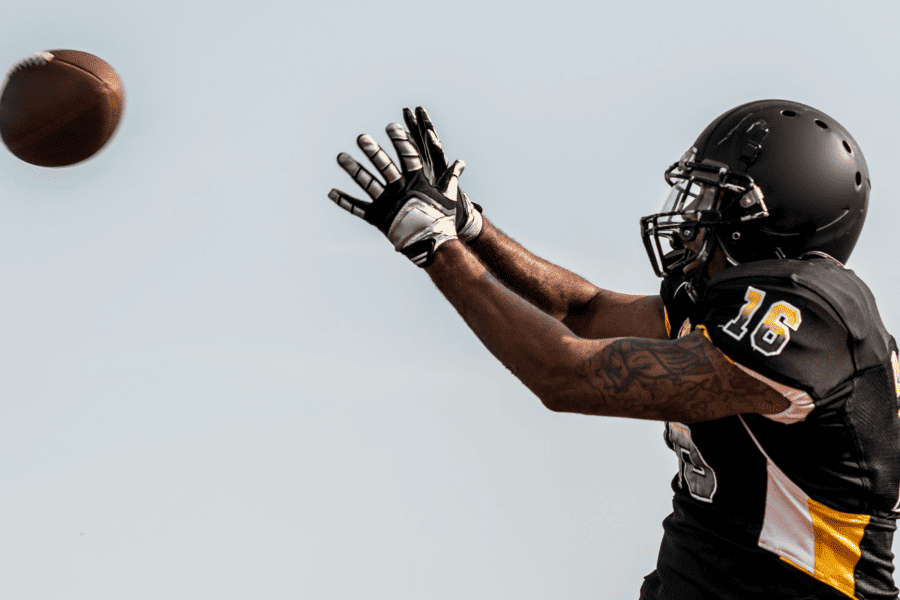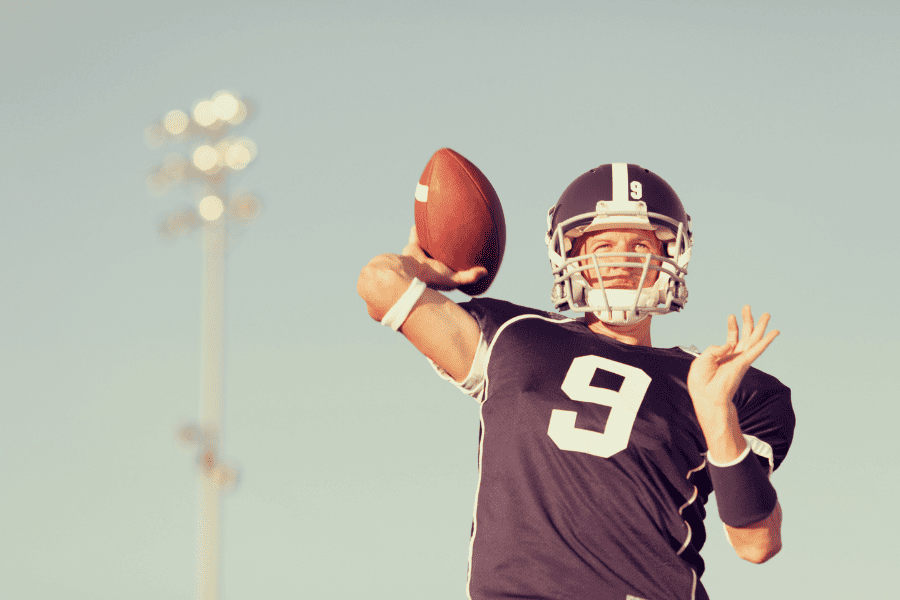What Does a Wide Receiver Do in Football? (Simply Explained)
The wide receiver, often referred to simply as a ‘receiver’, is primarily responsible for catching passes thrown by the quarterback. Positioned on the end of the line of scrimmage (typically separate from the offensive line) or set back slightly behind the line, wide receivers serve as the primary targets for forward passes.
They run precise routes dictated by the play called in the huddle, and their main objective is to elude defenders and catch the ball to advance it toward the end zone for a touchdown, or at least gain significant yardage.
In this article, we’ll examine the role of the wide receiver in the offense in simple terms. In just a few moments you’ll understand what a wide receiver does, what their responsibilities are and how they fit as part of the offensive unit in football.
Understanding the Basics
To appreciate the complexity and significance of a wide receiver’s role, it is essential to understand the basics of what they do on the football field.
Wide Receiver’s Role

A wide receiver is an offensive player whose primary task is to catch passes from the quarterback. They line up towards the sidelines of the field, either at or behind the line of scrimmage, ready to sprint downfield the moment the ball is snapped. The exact path they take – the ‘route’ they run – is determined by the specific play being executed.
A wide receiver’s role goes beyond merely catching the ball.
They must elude or ‘beat’ their defenders, using speed, agility, and intricate footwork. Once they have caught the ball, they become a runner, aiming to gain as many yards as possible or even score a touchdown.
If a pass is not coming their way, a wide receiver may be required to block for other players or act as a decoy to distract the defense.
Key Responsibilities of a Wide Receiver
- Route Running: A crucial part of a wide receiver’s job is running routes, which are pre-determined paths designed to create space from defenders and provide an open target for the quarterback. Routes can vary greatly, from short slants to deep streaks down the field.
- Catching: The most visible part of the wide receiver’s job is catching passes. They need to be able to catch the ball reliably, often while running at full speed and under pressure from defenders.
- Yards After Catch (YAC): Once a wide receiver catches the ball, their job isn’t over. They need to gain as many yards as possible by running downfield. This often requires speed, strength, and the ability to elude tacklers.
- Blocking: Wide receivers are also responsible for blocking defenders, typically on running plays or when another receiver has the ball. Good blocking can be the key to a successful play.
- Reading the Defense: Wide receivers need to understand defensive alignments and adjust their routes on the fly based on what they see. This requires an in-depth understanding of the game and a good rapport with the quarterback.
- Ball Security: Once the ball is in their hands, it’s the wide receiver’s responsibility to secure it. Fumbles can be game-changing events, so ball security is paramount.
In short, a wide receiver’s role is multifaceted and demanding, requiring a blend of physical prowess and mental acuity.
Role of the Wide Receiver in Offensive Play
A wide receiver’s contribution extends beyond merely executing plays and catching passes; they also play a crucial part in manipulating defenses. Their movements and routes can draw defenders away from key areas of the field (basically acting as decoys), creating space for other offensive players to exploit.
As an example, wide receivers are instrumental in “stretching the field”. By posing a deep threat, they force the defense to spread out, which opens up opportunities for shorter passes and running plays.
The receiver’s versatility also allows for an array of play types.
Depending on the strategy, they can be utilized in quick short-yardage plays to get a first down, or in high-risk, high-reward long passes to gain large chunks of yardage quickly.
Examples of Routes Run by Wide Receivers

Wide receivers must master a variety of routes and patterns, each with its unique purpose and strategy.
There can be over a dozen different routes in any particular playbook, but here are some of the most common:
- Slant: The receiver sprints a few yards downfield, then cuts diagonally towards the center of the field. This route is often used for quick, short gains.
- Out/In: In an out route, the receiver runs straight, then breaks towards the sideline. In an in route, the receiver breaks toward the center of the field instead. These are often used to exploit holes in zone coverage.
- Curl/Hitch: The receiver sprints downfield, then turns back towards the quarterback. This route is useful for making safe, reliable gains.
- Go/Deep: The receiver sprints straight down the field, aiming to get behind the defense for a long pass. This route can result in big plays and touchdowns but carries a higher risk of incomplete passes.
The Wide Receiver’s Collaboration with the Quarterback

The relationship between the quarterback and the wide receiver is a vital component of any successful football team. They must operate as a cohesive unit, with seamless communication, understanding, and timing to execute plays effectively.
Importance of Timing and Communication
The synchronization between a quarterback and a wide receiver is a delicate ballet.
Communication, both verbal and non-verbal, is essential.
Before the snap, the quarterback may alter the play based on the defensive setup, communicating these changes to the receiver with coded signals or phrases.
During the play, a receiver might need to alter their route based on how the defense reacts. This requires a deep understanding and connection between the quarterback and the wide receiver, often developed over years of practice.
Timing is also critical: the quarterback often throws the ball before the receiver has even finished running their route, anticipating where the receiver will be at the moment the ball arrives. A well-timed pass can be the difference between a significant gain and an incomplete pass or, worse, an interception.
On a deep pass, the quarterback relies on the receiver’s speed to get behind the defense, while the receiver trusts the quarterback to place the ball where only they can catch it.
On shorter routes, the quarterback must time the throw perfectly to coincide with the receiver’s cut, while the receiver has to create separation from the defender to provide a clear target.
In trickier plays, such as the back-shoulder throw, the quarterback aims the ball at the receiver’s back shoulder, trusting the receiver to adjust their route and body position to make the catch.
Their coordination, timing, and communication are the result of countless hours of practice and play a decisive role in the outcome of the game.
Skills Required for a Wide Receiver
Wide receivers are among the most skilled athletes on a football team, needing a mix of physical, technical, and mental abilities to excel at their position.
Physical Skills

- Speed: Speed is critical for a wide receiver. They need to be fast enough to outrun defenders, get open for passes, and create big plays. A fast wide receiver is a constant threat to the opposing defense, keeping them on their toes.
- Agility: Agility is the ability to change direction quickly without losing speed or balance. This is crucial for running precise routes, avoiding defenders, and gaining yards after the catch.
- Strength: While not as immediately apparent as speed or agility, strength is also important for a wide receiver. They need strength to fight off press coverage at the line of scrimmage, to hold onto the ball when tackled, and to effectively block defenders during running plays.
Technical Skills
- Route Running: Running precise routes is vital. A wide receiver must be able to swiftly and accurately follow the path designated in the play, whether it’s a short slant or a deep post.
- Catching: This may seem obvious, but a wide receiver must have excellent catching skills. They need to catch the ball reliably, often under pressure from defenders and while running at full speed.
- Blocking: Wide receivers are often required to block defenders, particularly on running plays or when another receiver has the ball. Effective blocking can be the key to a successful play.
Mental Skills
- Understanding Plays: Wide receivers must thoroughly understand each play, knowing where they need to be and when they need to be there. This requires studying the playbook and understanding the offensive strategy.
- Positioning: Being in the right place at the right time is crucial. Receivers must understand where they fit within the offensive formation, how to align themselves relative to the defenders, and where they need to be to make the catch.
- Decision Making: Good decision-making skills are critical, particularly when ‘reading the defense’. Receivers often have to adjust their routes based on the defensive coverage, requiring split-second decisions that could significantly impact the play.
As you can see, to become a successful wide receiver, one needs to cultivate a diverse set of physical, technical, and mental skills. The combination of these skills defines the proficiency of a wide receiver and their ability to contribute significantly to the team’s offensive success.
Notable Wide Receivers in NFL History
Over the years, numerous wide receivers have left an indelible mark on the game of football, not only with their exceptional skills and performances but also with their ability to redefine the role and potential of the wide receiver position.
- Jerry Rice: Often hailed as the greatest wide receiver in NFL history, Rice had an illustrious career, mostly with the San Francisco 49ers, spanning two decades from the mid-1980s to the early 2000s. His work ethic, precise route running, and reliable hands set a standard for the position. With numerous records to his name, including most career receiving yards and touchdowns, his contributions to the game are unmatched.
- Randy Moss: Known for his spectacular speed and leaping ability, Moss was a constant deep threat throughout his career, which included notable stints with the Minnesota Vikings and New England Patriots. He revolutionized the receiver position with his playmaking ability and reputation for making spectacular catches.
- Calvin Johnson: Nicknamed “Megatron” for his imposing size and athleticism, Johnson spent his entire career with the Detroit Lions. Despite often facing double or triple coverage, he consistently made stunning catches, thanks to his combination of size, speed, and catching ability.
- Larry Fitzgerald: Playing primarily with the Arizona Cardinals, Fitzgerald was renowned for his exceptional hands and route running. His consistency, reliability, and ability to make crucial catches in high-pressure situations have cemented his place among the all-time greats.
These legendary wide receivers have shaped the role of the position in modern football, setting standards in terms of skill, technique, and strategic value. Their remarkable careers serve as inspiration for future generations of wide receivers.
Final Thoughts
From running meticulously planned routes to making game-changing catches, wide receivers are often at the heart of a team’s offensive strategy. Their ability to stretch the field, create opportunities for other players, and manipulate defensive strategies are key aspects of the game.
The interplay between a wide receiver and the quarterback exemplifies the importance of teamwork, coordination, and communication in football.
The position of wide receiver has evolved significantly over the years, with legendary players like Jerry Rice, Randy Moss, and Calvin Johnson pushing the boundaries of what is expected and achievable at the position. These athletes have influenced the tactical dynamics of the game and shaped the way we perceive the wide receiver’s role today.
Looking toward the future, it’s clear that the wide receiver position will continue to evolve. As strategies become increasingly complex and athletes continue to push the limits of speed, strength, and agility, we can expect to see wide receivers taking on even more significant roles on the field.

